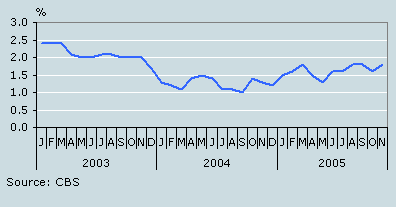Inflation rises in November

Inflation has risen to 1.8 percent in November. This is 0.2 of a percent point higher than in October this year. The increase was caused mainly by price increases for food and non-alcoholic beverages. Falling petrol prices restrained the inflation rate.
Consumer prices fell by an average of 0.2 percent from October to November this year. Despite this decrease on the previous month, inflation rose. In November last year prices fell by more compared with October last year. These developments led to a higher inflation rate.
Inflation in the Netherlands is measured as the change of the consumer price index compared with the same period twelve months previously. To allow international comparisons, inflation is calculated according to an European harmonised method as well.
The inflation rate in the Netherlands is one of the lowest in the eurozone. Dutch inflation according to the European harmonised method was 1.6 percent in November. This is 0.1 of a percent point higher than in October 2005. The inflation rate in the eurozone in October was 2.5 percent on average. According to the statistical office of the European Union (Eurostat) the inflation in the eurozone is expected to fall slightly in November, to an average 2.4 percent.
According to the Consumer Confidence Survey more than half of Dutch consumers believe that prices have risen either moderately or strongly in the past twelve months. In November the percentage of consumers believing so reached its lowest point since the summer of 2000. The percentage of consumers expecting a stronger rise in consumer prices in the coming twelve months has increased in recent months; it has reached its highest point since the beginning of 2002.
Inflation
